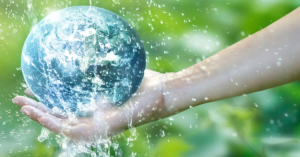Physical Address
23,24,25 & 26, 2nd Floor, Software Technology Park India, Opp: Garware Stadium,MIDC, Chikalthana, Aurangabad, Maharashtra – 431001 India
Physical Address
23,24,25 & 26, 2nd Floor, Software Technology Park India, Opp: Garware Stadium,MIDC, Chikalthana, Aurangabad, Maharashtra – 431001 India

Water is a precious resource that sustains life and ecosystems. Water is the basic necessity for the functioning of all life forms that exist on earth. It is safe to say that water is the reason behind Earth being the only planet to support life. As such, it’s crucial to treat it with care, use it wisely, and work toward ensuring equitable access to clean and safe water for all.
Several global challenges related to water include managing water scarcity, providing access to clean and safe drinking water for all, and fundamental challenges due to climate change.
Water Cycle and its importance
Water is vital for all forms of life. It is crucial in various biological processes, including digestion, circulation, and temperature regulation in living organisms. We all receive water from the water cycle. The water cycle, also known as the hydrological cycle, is the continuous movement of water on, above, and below the surface of the Earth. It involves processes like evaporation, condensation, precipitation, and runoff. Water evaporates from bodies of water, forms clouds through condensation, and falls back to the Earth as precipitation, replenishing water sources.
Climate change and water stress
Water stress or scarcity occurs when the demand for safe, usable water in a given area exceeds the supply. On the demand side, the vast majority of the world’s freshwater is used for agriculture, while the rest is divided between industrial and domestic uses, including for drinking. More can be read here,
Climate change will likely exacerbate water stress worldwide, as rising temperatures lead to more unpredictable weather and extreme weather events, including floods and droughts.
An increase in the air temperature will also cause water temperatures to increase. Water pollution problems will increase as water temperatures rise, and many aquatic habitats will be negatively affected. Increases in water temperatures are expected to result in the following,
Lower levels of dissolved oxygen due to the inverse relationship between dissolved oxygen and temperature.

As the temperature of the water increases, dissolved oxygen levels decrease. It increases invasive species in water bodies, pathogens and algal blooms. High temperatures rise in concentrations of some pollutants, such as ammonia and pentachlorophenol, due to their chemical response to warmer temperatures. You can read it here,
On the other hand, it leads to the loss of aquatic species whose survival and breeding are temperature-dependent. Change in the abundance and spatial distribution of coastal and marine species and decline in populations of some species.
Climate change can cause shifts in precipitation patterns, leading to more intense and frequent extreme weather events like heavy rainfall and droughts. This can result in flooding in some areas and water scarcity in others.
Melting Glaciers and Sea level rise
Human activities are at the root of this phenomenon. Specifically, since the industrial revolution, carbon dioxide and other greenhouse gas emissions have raised temperatures even higher in the poles. As a result, glaciers are rapidly melting, calving off into the sea and retreating on land. More can read here: Rising sea levels can lead to saltwater intrusion into coastal freshwater aquifers, contaminating drinking water supplies. Coastal areas are also at increased risk of flooding and erosion.
Droughts and Water Scarcity
According to the World Meteorological Department, drought is a natural climatic feature of below-average precipitation, which can last for months or years, while water scarcity results from a long-term imbalance between water demand and supply. However, climate change has impacted more extended drought periods due to the water cycle changes. Drought and water scarcity are often interrelated, and droughts can trigger or amplify water scarcity, while water scarcity can aggravate droughts. Altered precipitation patterns and higher evaporation rates can lead to more frequent and severe droughts, reducing freshwater availability for agriculture, industry, and communities.
Ecosystem Disruption
Changes in water availability and temperature can disrupt aquatic ecosystems. Higher water temperatures can stress marine organisms, alter habitats, and reduce biodiversity. Many animals die off when an area loses a large percentage of its fresh water. In some cases, species go entirely extinct. This leads to a decrease in the region’s biodiversity. On the other hand, Water pollution is a significant issue that’s significantly impacting species’ lives.
Impacts on Industries
Changes in water availability mainly affect the agriculture sector. It can affect crop irrigation, leading to decreased agricultural productivity. Droughts and water scarcity can also lead to food insecurity in some regions.
Increased flooding and rising sea levels can damage water-related infrastructure, including dams, levees, and water treatment facilities, disrupting water supply and sanitation systems. Waterborne diseases can become more prevalent as changing water conditions and extreme weather impact sanitation and water quality.
In a nutshell
Water has been severely impacted by climate change. Changes in the water cycle result in many issues, such as changes in precipitation patterns, evaporation rates, etc. This case negatively affects all living organisms in the world. Sustainable water management practices, investment in water infrastructure, promotion of water conservation, development of early warning systems for extreme weather events, and global efforts to reduce greenhouse gas emissions need to mitigate further climate change to protect the rights of all living organisms to use water properly.
If you have any queries or come across suspicious content related to climate change or the environment and want us to verify them for you, then send them to us on our WhatsApp hotline: +917045366366